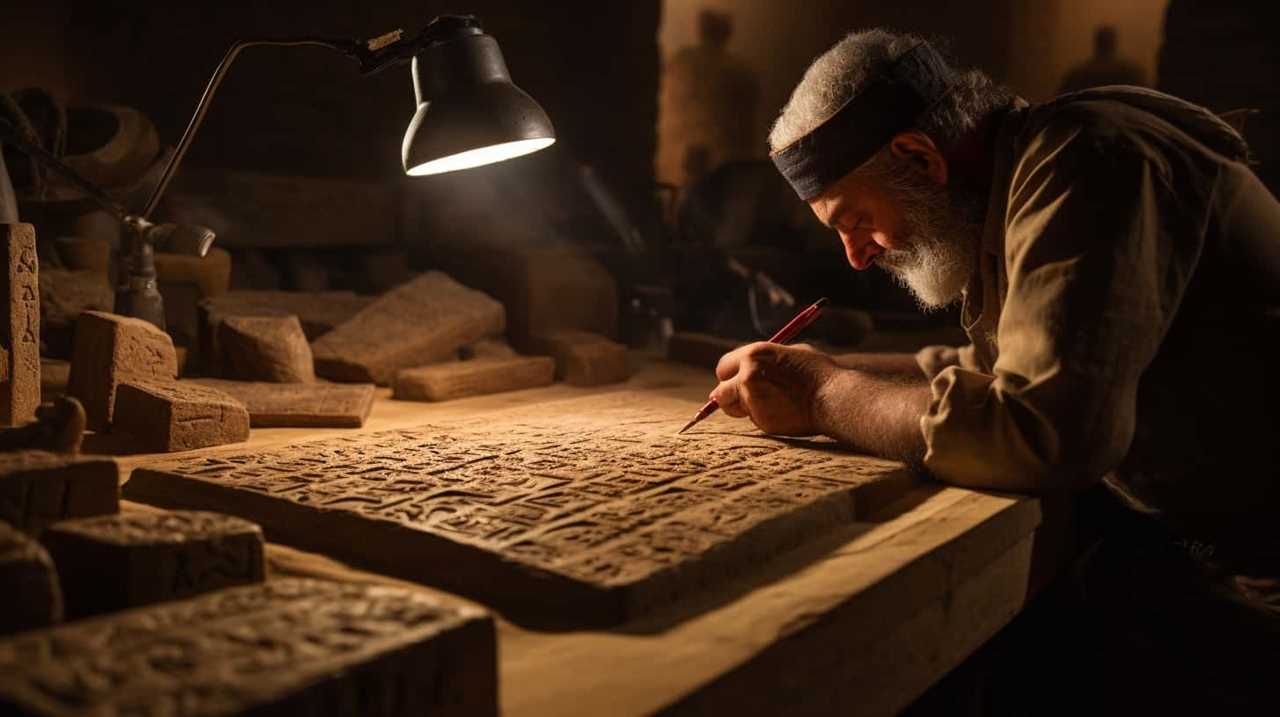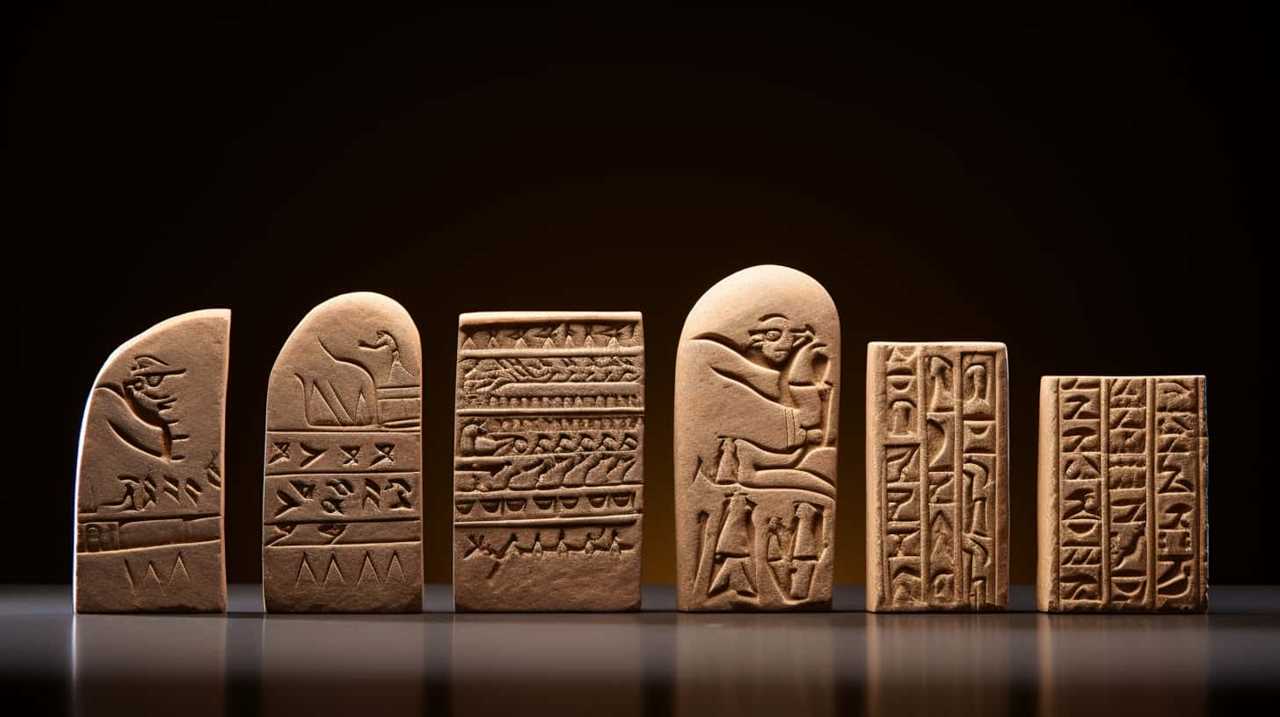What is the true message behind Mesopotamian writings?
In our journey to uncover the ancient wisdom of Mesopotamia, we delve into the realm of inscriptions that hold the key to unlocking the secrets of this fascinating civilization.
Through the study of these texts, we embark on a quest to understand the profound messages they convey and the profound impact they had on Mesopotamian society and culture.
As we immerse ourselves in the language and script of these literary treasures, we gain invaluable insights into the lives of the people who lived in this ancient land.

Join us as we decipher the coded messages and unravel the hidden meanings of Mesopotamian texts, piecing together the puzzle of a civilization lost in time.
Key Takeaways
- Mesopotamian texts offer valuable insights into the culture, governance, and daily life of ancient Mesopotamia.
- They cover a wide range of subjects including law, religion, literature, and science, providing a deeper understanding of shared human history.
- Mesopotamian texts provide valuable information about the daily lives, social structures, and religious practices of the Mesopotamian society.
- Deciphering and understanding Mesopotamian texts is a challenging task, but progress has been made in unlocking the mysteries of cuneiform script.
Historical Significance of Mesopotamian Inscriptions
The historical significance of Mesopotamian inscriptions lies in their ability to provide insight into the ancient civilization’s culture, governance, and daily life. These inscriptions, discovered through archaeological excavations, have presented scholars with a wealth of information that has contributed to our understanding of this fascinating civilization.
However, translating these inscriptions poses significant challenges due to the complexity of the ancient Mesopotamian languages and the fragmented nature of the texts.
One of the major translation challenges is the decipherment of cuneiform script, the writing system used by the Mesopotamians. This script consists of wedge-shaped marks made on clay tablets, which were then baked to preserve the inscriptions. Deciphering these texts requires not only a thorough knowledge of the grammar and vocabulary of the ancient languages but also an understanding of the cultural context in which they were written.

Despite these challenges, archaeological discoveries have provided invaluable insights into Mesopotamian society. For example, the Code of Hammurabi, one of the most famous Mesopotamian inscriptions, offers a glimpse into the ancient legal system and social structure. Similarly, administrative texts provide detailed information about the governance and economic practices of the time.
Discovering the Wisdom of Ancient Mesopotamia
As we delve into the rich world of ancient Mesopotamia, we uncover the profound wisdom embedded within its texts. The wisdom of ancient Mesopotamia is a treasure trove of ancient knowledge waiting to be explored. These texts, written on clay tablets and preserved through the ages, provide insight into the beliefs, values, and intellectual pursuits of the people who inhabited this ancient land.
The wisdom found in Mesopotamian texts encompasses a wide range of subjects, including law, religion, literature, and science. These texts offer valuable insights into the social and cultural norms of the time, as well as the intellectual prowess of the Mesopotamian scribes. From the Code of Hammurabi, which laid out a comprehensive legal system, to the Enuma Elish, an epic creation myth, these texts provide a window into the ancient worldview.
Exploring the wisdom of ancient Mesopotamia allows us to gain a deeper understanding of our shared human history. It enables us to appreciate the intellectual achievements of these ancient civilizations and recognize the enduring relevance of their ideas. By studying these texts, we can learn from the wisdom of the past and apply it to our present-day challenges.

Insights Into Mesopotamian Society and Culture
We uncover fascinating insights into Mesopotamian society and culture through the examination of their ancient texts. By studying these texts and analyzing the information they provide, we can gain a deeper understanding of the daily lives, social structures, and religious practices of the people of Mesopotamia.
Archaeological artifacts play a crucial role in this process, as they provide tangible evidence that supports the information found in the texts. For example, the discovery of clay tablets containing administrative records helps us understand the complex bureaucracy and economic systems of Mesopotamian society. These records reveal details about trade, taxation, and the distribution of resources, shedding light on the economic structure and organization of the civilization.
Religious practices were deeply ingrained in Mesopotamian society, and their texts offer valuable insights into these beliefs and rituals. Through the examination of hymns, prayers, and incantations, we can learn about the gods and goddesses worshipped by the Mesopotamians, as well as the rituals and ceremonies associated with their worship. This knowledge allows us to comprehend the role of religion in shaping social norms, political structures, and even daily routines.
Unveiling the Secrets of Mesopotamian Texts
Continuing our exploration into Mesopotamian society and culture, we frequently delve into the secrets embedded within their ancient texts. Unveiling the secrets of Mesopotamian texts is a captivating endeavor that requires meticulous study and expertise in the fields of Mesopotamian language decipherment and Mesopotamian cuneiform translation.

To truly understand these ancient texts, scholars have dedicated years to deciphering the complex script of cuneiform. This system of writing, consisting of wedge-shaped impressions on clay tablets, was used by the ancient Mesopotamians to record their thoughts, laws, and myths. Deciphering cuneiform has been a monumental task, but through meticulous analysis and comparison with known languages, scholars have made significant progress in unlocking its mysteries.
One method used in the decipherment process is the identification of repeated signs or patterns in the texts. By comparing these signs with known languages and identifying common words or phrases, scholars have been able to piece together the meaning of many Mesopotamian texts. Additionally, the study of grammar and syntax has provided further insights into the structure and organization of the language.
Through the decipherment of Mesopotamian texts, scholars have gained valuable insights into the society, culture, and beliefs of the ancient Mesopotamians. These texts offer a unique window into their daily lives, religious practices, and even their thoughts on topics such as law and governance. The decipherment of these texts has truly been a monumental achievement, shedding light on a civilization that would have otherwise remained shrouded in mystery.
Unearthing Mesopotamian Literary Treasures
Building upon our exploration into the secrets of Mesopotamian texts, we now delve into the fascinating world of unearthing Mesopotamian literary treasures. The process of unearthing ancient artifacts and deciphering ancient scripts has been a vital endeavor for archaeologists and linguists alike.

Through meticulous excavation and careful analysis, these scholars have uncovered a wealth of literary works from the ancient civilizations of Mesopotamia, providing us with invaluable insights into their culture, history, and beliefs.
The unearthing of ancient artifacts is a complex and labor-intensive process. Archaeologists meticulously excavate sites, often layer by layer, in search of these literary treasures. Once discovered, these artifacts are carefully preserved and documented to ensure their protection and future study.
Deciphering ancient scripts is no less challenging. Ancient Mesopotamian texts were written in several languages, including Sumerian and Akkadian. Scholars painstakingly decode these scripts, comparing them with known linguistic systems and utilizing specialized knowledge of grammar and vocabulary.
The decipherment of ancient texts has yielded remarkable results. We’ve gained access to epic poems such as the Gilgamesh Epic, which explores themes of mortality and the search for immortality. We’ve discovered legal codes like the Code of Hammurabi, shedding light on ancient Mesopotamian laws and social structures. These literary treasures not only provide us with historical and cultural insights but also challenge our understanding of human civilization and its development.

Examining the Language and Script of Mesopotamian Inscriptions
As we delve into the language and script of Mesopotamian inscriptions, we uncover the intricacies and nuances of this ancient writing system. Through rigorous linguistic analysis and the deciphering of tablets, we gain a deeper understanding of the Mesopotamian civilization and their rich literary heritage.
Here are some key aspects to consider:
- Cuneiform Script: Mesopotamian inscriptions were written in cuneiform, a script characterized by wedge-shaped marks made on clay tablets. Each mark represented a specific sound or word, allowing for a wide range of expression. The script evolved over time and was used to write several languages, including Sumerian, Akkadian, and Babylonian.
- Language Varieties: Mesopotamian inscriptions provide evidence of different language varieties spoken in the region. The scripts allow us to analyze the grammar, vocabulary, and syntax of ancient Mesopotamian languages, providing a window into the linguistic diversity of the time.
- Writing Techniques: The tablets reveal various writing techniques employed by Mesopotamian scribes. Different styles of handwriting, use of abbreviations, and the inclusion of colophons all contribute to our understanding of the scribe’s role and the context in which the tablets were created.
- Cultural Context: The language and script of Mesopotamian inscriptions not only provide a glimpse into the linguistic aspects but also offer insights into the social, economic, and religious aspects of the civilization. By examining the content of the tablets, we can learn about trade, law, religion, and literature in ancient Mesopotamia.
Through linguistic analysis and the deciphering of tablets, we continue to uncover the secrets of Mesopotamian inscriptions, shedding light on a fascinating civilization that once thrived in the cradle of human civilization.
Decoding the Messages of Mesopotamian Texts
Once we understand the intricacies of the language and script, we can begin to decode the messages hidden within Mesopotamian texts. Deciphering symbols and understanding the ancient context are crucial aspects of this process. Mesopotamian texts, consisting of cuneiform inscriptions on clay tablets, provide invaluable insights into the culture, society, and history of ancient Mesopotamia.

Decoding these texts requires a comprehensive understanding of the cuneiform script, which was used to represent both syllables and logograms. By analyzing the individual signs and their meanings, we can start to decipher the words and sentences contained within the texts. Additionally, knowledge of the grammar and vocabulary of the ancient languages, such as Sumerian and Akkadian, is essential in unraveling the full meaning of the texts.
Understanding the ancient context is equally important in decoding the messages of Mesopotamian texts. The texts often refer to specific historical events, religious practices, and social customs that were prevalent during that time. By grounding our interpretation in the cultural and historical context of ancient Mesopotamia, we can gain a deeper understanding of the intended meaning behind the texts.
Frequently Asked Questions
What Are Some Common Themes or Motifs Found in Mesopotamian Literary Texts?
In Mesopotamian literary texts, we find common themes and motifs such as the complex relationships between humans and animals, the immense power wielded by gods and goddesses, and the exploration of cultural traditions and human emotions like love and grief.
How Were Mesopotamian Inscriptions and Texts Preserved Over Time?
Preservation techniques used in Mesopotamia allowed for the survival of their inscriptions and texts. Archaeological discoveries reveal the use of clay tablets, sealing, and burial practices, ensuring that these important texts could be passed down through generations.

Were Mesopotamian Texts Primarily Used for Religious or Secular Purposes?
Mesopotamian texts had both religious and secular purposes, reflecting their cultural context and religious significance. They provided insights into daily life, law, literature, and worship, contributing to our understanding of ancient Mesopotamian civilization.
What Methods or Technologies Were Used to Decode the Messages of Mesopotamian Texts?
Decoding techniques for Mesopotamian texts, such as cuneiform decipherment, were crucial in understanding their messages. By analyzing linguistic patterns, comparing known languages, and utilizing advanced technologies, scholars unraveled the secrets hidden within these ancient writings.
Can Mesopotamian Texts Provide Insights Into Other Ancient Civilizations Beyond Their Own Region?
Comparative analysis of Mesopotamian texts can provide valuable insights into other ancient civilizations. By examining cross-cultural influences, we can uncover the interconnectedness of different regions and gain a deeper understanding of the broader ancient world.
What Are Some Revealing Quotes from Mesopotamian Texts?
Many timeless Mesopotamian quotes revealed the ancient civilization’s deep understanding of life and the world. “The gods are not to blame when humans wallow in misery,” is a particularly revealing quote that highlights the Mesopotamians’ belief in personal responsibility and the role of divine forces in human affairs.
Conclusion
In conclusion, the study of Mesopotamian texts has provided invaluable insights into the ancient society and culture of this region. Through the deciphering of their language and script, historians have been able to decode the messages and uncover the secrets hidden within these texts.

The discovery of ancient literary treasures has further enriched our understanding of Mesopotamian wisdom and knowledge. One fascinating statistic is that over 500,000 cuneiform tablets have been excavated so far, each containing valuable information about the lives and beliefs of the people of Mesopotamia.
Fritz is a writer whose humor and wit infuse life into words. His creativity, combined with a profound love for the English language, makes him a unique voice at afterQuotes. Fritz’s engagement with books, culture, and social media adds depth to his contributions, making them resonate with our diverse audience.










